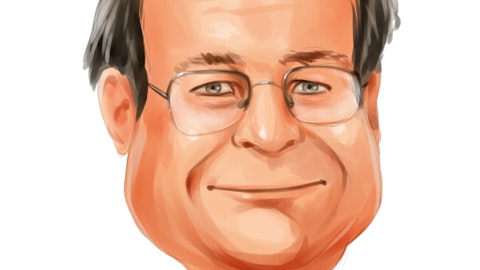Andrew Clyde: Thank you.
Operator: Your next question comes from the line of Ben Bienvenu with Stephens. Your line is open.
Ben Bienvenu: Hey. Good morning.
Andrew Clyde: Good morning.
Ben Bienvenu: I was hoping to revisit fourth quarter results a little bit on the in-store, and to the extent if you could, I’d love to hear commentary on cadence during the quarter and then you talked about the initial start to 1Q. As we contended with weather in the fourth quarter and now weather across the Southeast in the first quarter, is that creating variability in the results month-to-month or is that a nonfactor?
Andrew Clyde: Yeah. Look, weather ultimately becomes a nonfactor because you got pre-buying, you got post-buying and the like, and so unless you have a much more extended event it’s usually not a big factor. Look, certainly, from a gallon standpoint, October started off stronger, because of where it was in the price fall off versus December. That in turn impacts the traffic inside the store over that same period as well. So there’s probably some deceleration within the three months. I think what has really got us excited about the start to the year. If I look at January then, on the Murphy side merchandise transactions in total, are up 10%, leading to sales and merchandise margin up 9.5% and 10.3%, double-digit trip growth on top of the 4% volume growth is really impactful.
Look at QuickChek, we are seeing transactions up 5% and some of that’s still being weighed down by nicotine products and our Murphy centralized team has been working within some of the state minimum constraints that we deal with in New Jersey. So, certainly, a little deceleration within the quarter, but as we start the new year, we are seeing nice acceleration across the Board.
Ben Bienvenu: Okay. Great. Shifting gears a little bit to the cash flow statement. CapEx was up — you talked about new investments in SG&A. You also talked about kind of long-lived investments in the CapEx side of things. Is this kind of $400 million CapEx midpoint, the new normal would you expect us to continue to grow? Is it the peak kind of give us some sense as we look out several years from now for what your CapEx spend might look like?
Andrew Clyde: Yeah. I think it’s probably more in line with the new normal. What I would expect if I look across the buckets, Mindy went over between growth sustaining corporate and initiatives, some peak around some of the IT capitalized, around some of the initiatives like digital transformation. Those things tend to be a little bit more episodic like Murphy Drive Rewards. We also have our, we call it, our Common Systems Environment project, where we are looking across both QuickChek and Murphy USA, and making the choices for the future about the systems environment. So some of that corporate initiatives could come down as we get some of that one-time work done. From a sustaining standpoint, the more new stores and raze-and-rebuilds, we have those programs that are in growth, reduce some of the programmatic things from a sustaining standpoint.
But if you continue to build the network, there’s some puts and takes there. From an overall growth standpoint, we are still not at, I think, what our true potential is in terms of new store opportunities. Fortunately, we have had the opportunity to backfill that gap and maintain the productivity of our launch are building partner or general contractors through raze-and-rebuilds. But for us, even with the cost inflation that we are having, this is an attractive time to build stores. One of the things we talked about on the last call was we may be seeing inflation of $400,000 to $600,000 for our raze-and-rebuilds and our new builds, but for every $100,000 of capital, you need about $0.04 per gallon margin to cover that. So maybe you need another $0.02, $0.025, but we have consistently seen well over $0.10 margin.
So our capital return projects look even more attractive. Raze-and-rebuilds that were below an economic threshold, even though they had the land and the economics are now above that threshold. And so that is the one area that I think we could continue to see that cadence play out as we grow more stores, we get some of the bottlenecks that we talked about behind us and we continue to evaluate the opportunities on our raze-and-rebuilds going forward.
Ben Bienvenu: Okay. Thank you.
Operator: Your next question is from the line of John Royall with JPMorgan. Your line is open.
John Royall: Hi, guys. Good morning. Thanks for taking the question. So my first one is on capital allocation and so you have drawn down cash in the past three quarters, you have been buying back stock in excess of your free cash flow, your balance sheet is certainly in a good shape. But should we think about 2023 as another year where you might buy back more stock than your free cash and particularly in light of the higher CapEx budget, and as you pointed out, there’s actually a good return on holding cash right now. So just looking for thoughts on just currencies and buybacks can be maintained?
Andrew Clyde: Sure. We certainly front-loaded the $1 billion authorization we got from the Board, and frankly, no different than the $500 million authorization we got before that. We are certainly — we are confident buying at $280 for the long-term and part of that is evidenced by the fact that our weighted average cost of treasury stock is about $103. So we are focused on the long-term. As we think about free cash flow, we talked about the margin, where is there more upside than downside on that. We have typically seen events that are adding more pressure to the marginal retailer, not less, more volatility versus less. So there’s a of wildcards there that can continue to generate excess free cash flow above and beyond what our base case plan might be.
So as we have said in the past, our number one priority for allocating excess free cash flow when we get it is share repurchase and that is what we did in 2022. When we earned it, when we received it, when we put it in the bank, we allocated that. So you should look for that same cadence going forward. Look, I would also say, leverage as part of our long-term algorithm, Mindy highlighted our ratios that are very conservative. The business is still a free cash flow machine. We have a conservative balance sheet with a lot of free board and so we always think about our entire balance sheet and how we want to manage our growth algorithm for both new stores and the balance part around share repurchase. So I hope that provides some insight into how we are thinking about it.




